2012 MERCEDES-BENZ GL light
[x] Cancel search: lightPage 36 of 384
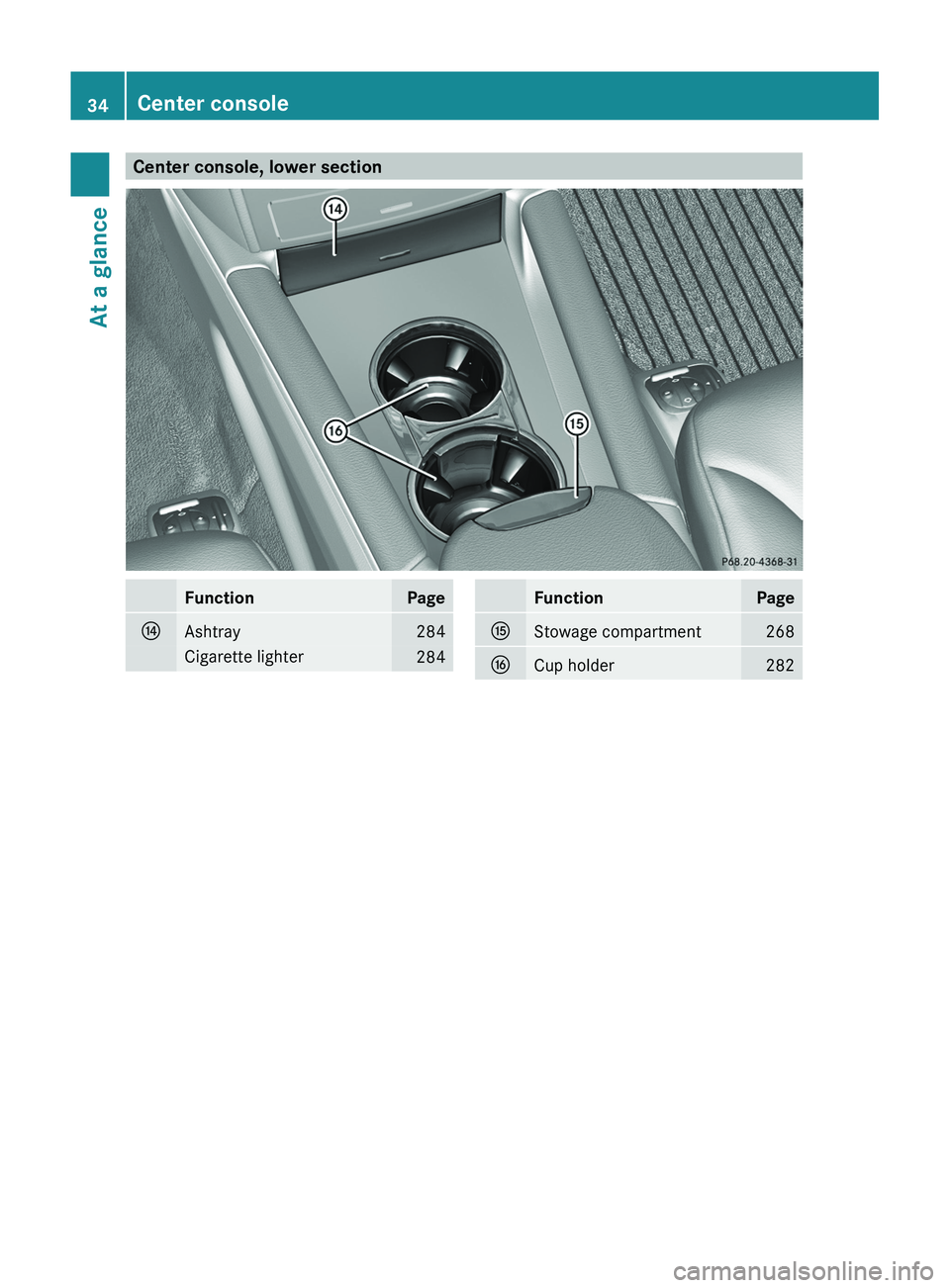
Center console, lower sectionFunctionPageJAshtray284Cigarette lighter284FunctionPageKStowage compartment268LCup holder28234Center consoleAt a glance
Page 37 of 384
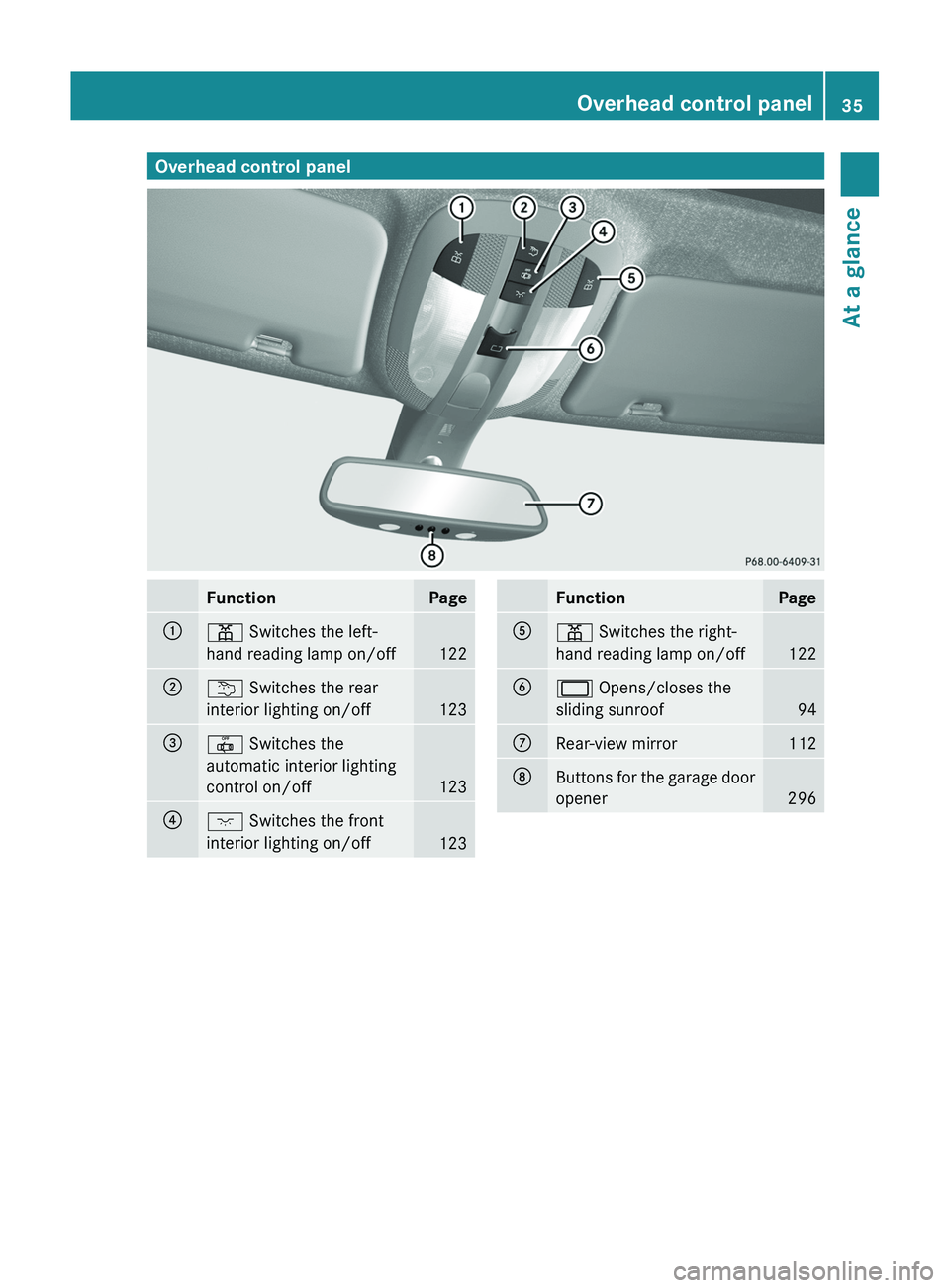
Overhead control panelFunctionPage:p Switches the left-
hand reading lamp on/off
122
;u Switches the rear
interior lighting on/off
123
=| Switches the
automatic interior lighting
control on/off
123
?c Switches the front
interior lighting on/off
123
FunctionPageAp Switches the right-
hand reading lamp on/off
122
B2 Opens/closes the
sliding sunroof
94
CRear-view mirror112DButtons for the garage door
opener
296
Overhead control panel35At a glance
Page 40 of 384
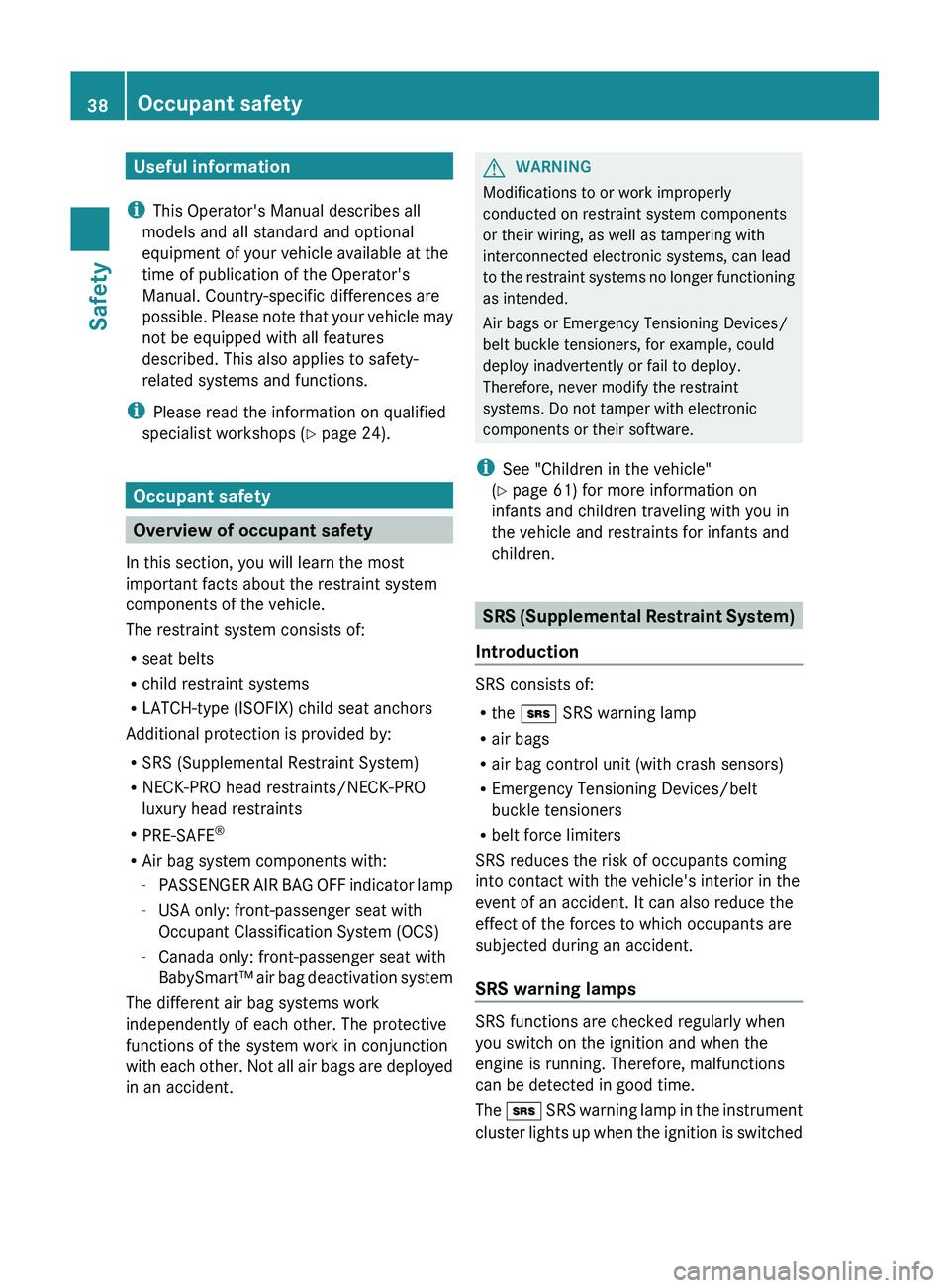
Useful information
i This Operator's Manual describes all
models and all standard and optional
equipment of your vehicle available at the
time of publication of the Operator's
Manual. Country-specific differences are
possible. Please note that your vehicle may
not be equipped with all features
described. This also applies to safety-
related systems and functions.
i Please read the information on qualified
specialist workshops ( Y page 24).
Occupant safety
Overview of occupant safety
In this section, you will learn the most
important facts about the restraint system
components of the vehicle.
The restraint system consists of:
R seat belts
R child restraint systems
R LATCH-type (ISOFIX) child seat anchors
Additional protection is provided by:
R SRS (Supplemental Restraint System)
R NECK-PRO head restraints/NECK-PRO
luxury head restraints
R PRE-SAFE ®
R Air bag system components with:
- PASSENGER AIR BAG OFF indicator lamp
- USA only: front-passenger seat with
Occupant Classification System (OCS)
- Canada only: front-passenger seat with
BabySmart™ air bag deactivation system
The different air bag systems work
independently of each other. The protective
functions of the system work in conjunction
with each other. Not all air bags are deployed
in an accident.
GWARNING
Modifications to or work improperly
conducted on restraint system components
or their wiring, as well as tampering with
interconnected electronic systems, can lead
to the restraint systems no longer functioning
as intended.
Air bags or Emergency Tensioning Devices/
belt buckle tensioners, for example, could
deploy inadvertently or fail to deploy.
Therefore, never modify the restraint
systems. Do not tamper with electronic
components or their software.
i See "Children in the vehicle"
( Y page 61) for more information on
infants and children traveling with you in
the vehicle and restraints for infants and
children.
SRS (Supplemental Restraint System)
Introduction
SRS consists of:
R the + SRS warning lamp
R air bags
R air bag control unit (with crash sensors)
R Emergency Tensioning Devices/belt
buckle tensioners
R belt force limiters
SRS reduces the risk of occupants coming
into contact with the vehicle's interior in the
event of an accident. It can also reduce the
effect of the forces to which occupants are
subjected during an accident.
SRS warning lamps
SRS functions are checked regularly when
you switch on the ignition and when the
engine is running. Therefore, malfunctions
can be detected in good time.
The + SRS warning lamp in the instrument
cluster lights up when the ignition is switched
38Occupant safetySafety
Page 44 of 384
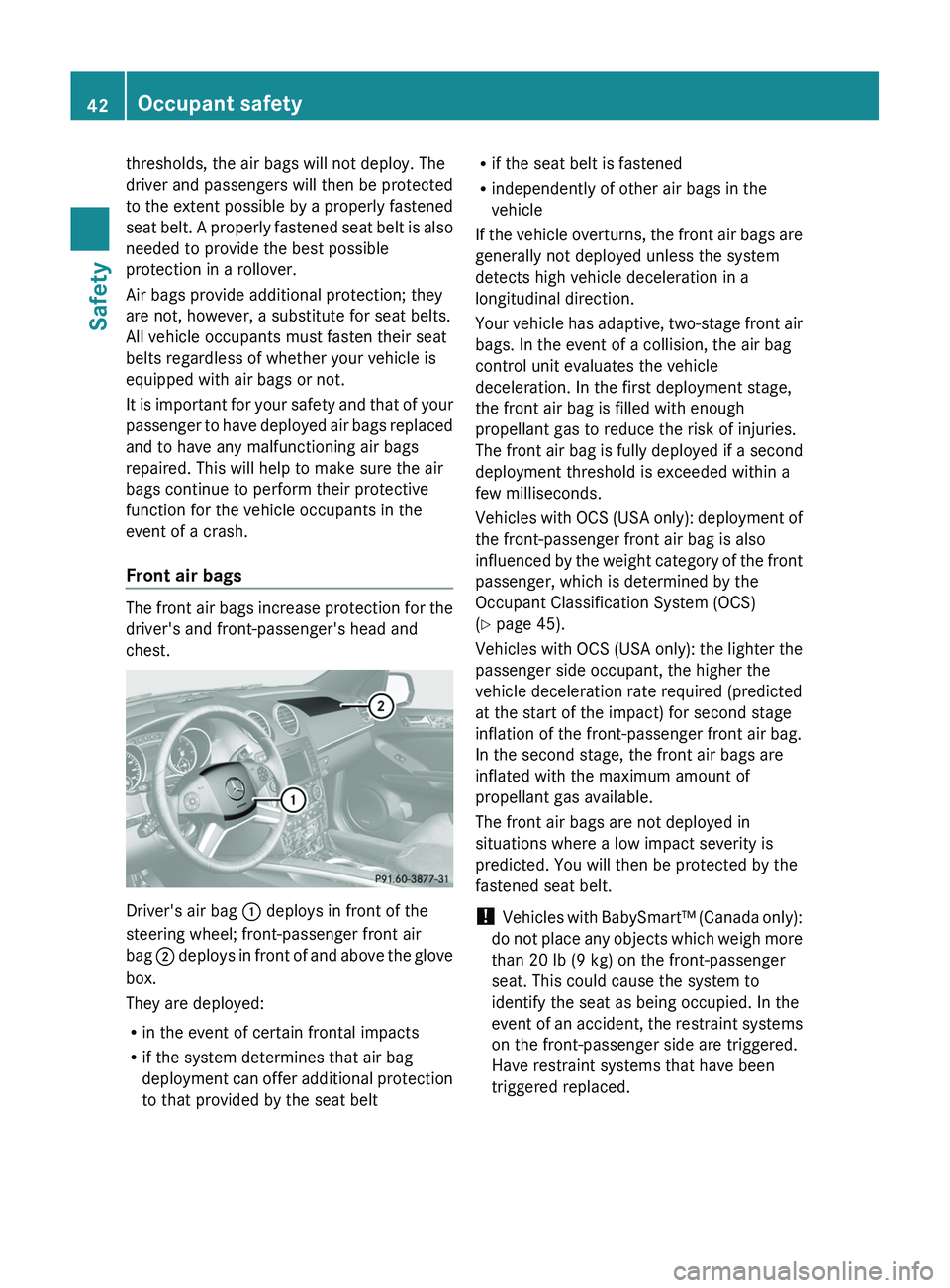
thresholds, the air bags will not deploy. The
driver and passengers will then be protected
to the extent possible by a properly fastened
seat belt. A properly fastened seat belt is also
needed to provide the best possible
protection in a rollover.
Air bags provide additional protection; they
are not, however, a substitute for seat belts.
All vehicle occupants must fasten their seat
belts regardless of whether your vehicle is
equipped with air bags or not.
It is important for your safety and that of your
passenger to have deployed air bags replaced
and to have any malfunctioning air bags
repaired. This will help to make sure the air
bags continue to perform their protective
function for the vehicle occupants in the
event of a crash.
Front air bags
The front air bags increase protection for the
driver's and front-passenger's head and
chest.
Driver's air bag : deploys in front of the
steering wheel; front-passenger front air
bag ; deploys in front of and above the glove
box.
They are deployed:
R in the event of certain frontal impacts
R if the system determines that air bag
deployment can offer additional protection
to that provided by the seat belt
R if the seat belt is fastened
R independently of other air bags in the
vehicle
If the vehicle overturns, the front air bags are
generally not deployed unless the system
detects high vehicle deceleration in a
longitudinal direction.
Your vehicle has adaptive, two-stage front air
bags. In the event of a collision, the air bag
control unit evaluates the vehicle
deceleration. In the first deployment stage,
the front air bag is filled with enough
propellant gas to reduce the risk of injuries.
The front air bag is fully deployed if a second
deployment threshold is exceeded within a
few milliseconds.
Vehicles with OCS (USA only): deployment of
the front-passenger front air bag is also
influenced by the weight category of the front
passenger, which is determined by the
Occupant Classification System (OCS)
( Y page 45).
Vehicles with OCS (USA only): the lighter the
passenger side occupant, the higher the
vehicle deceleration rate required (predicted
at the start of the impact) for second stage
inflation of the front-passenger front air bag.
In the second stage, the front air bags are
inflated with the maximum amount of
propellant gas available.
The front air bags are not deployed in
situations where a low impact severity is
predicted. You will then be protected by the
fastened seat belt.
! Vehicles with BabySmart™ (Canada only):
do not place any objects which weigh more
than 20 lb (9 kg) on the front-passenger
seat. This could cause the system to
identify the seat as being occupied. In the
event of an accident, the restraint systems
on the front-passenger side are triggered.
Have restraint systems that have been
triggered replaced.42Occupant safetySafety
Page 49 of 384
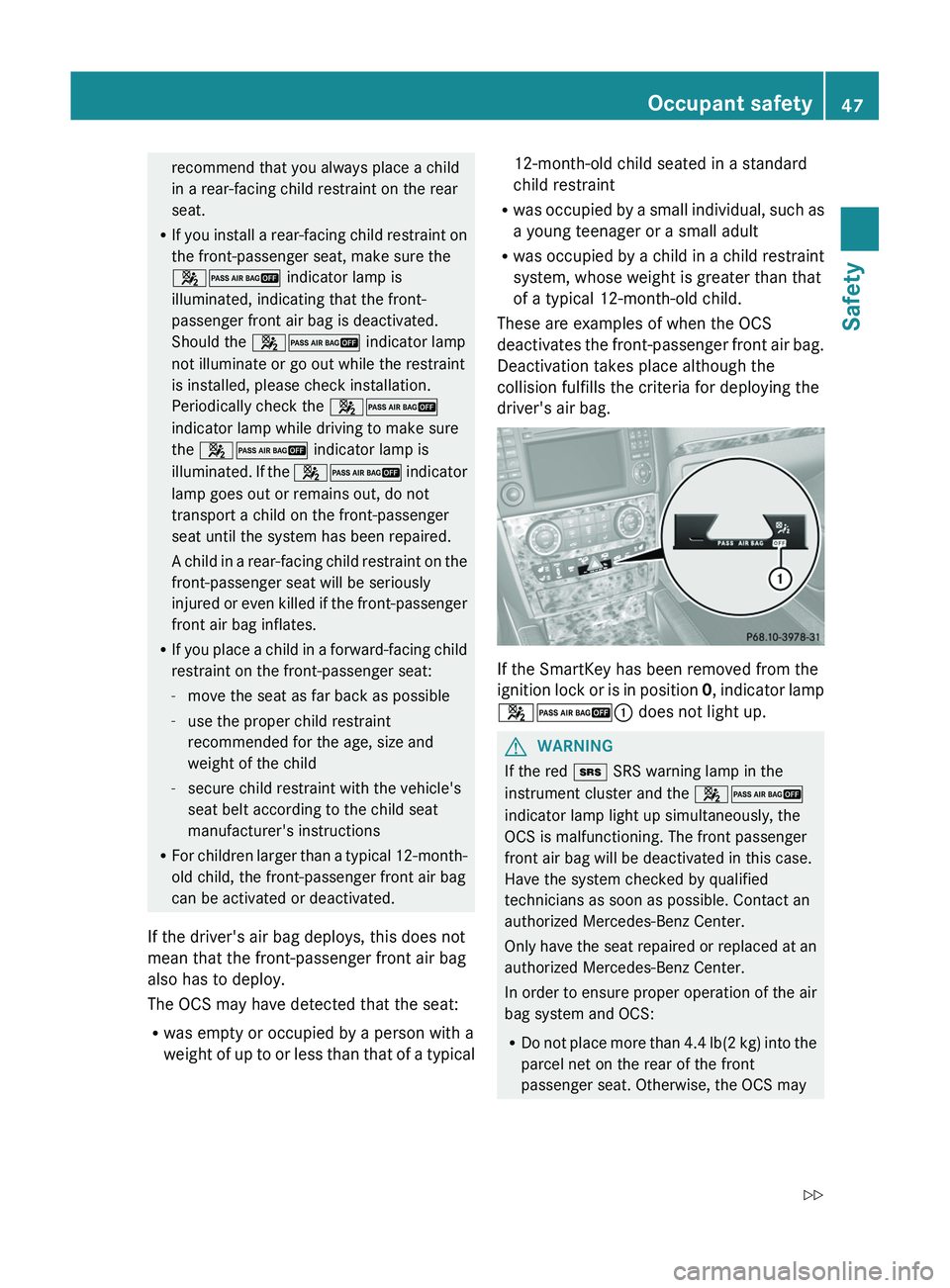
recommend that you always place a child
in a rear-facing child restraint on the rear
seat.
R If you install a rear-facing child restraint on
the front-passenger seat, make sure the
42 indicator lamp is
illuminated, indicating that the front-
passenger front air bag is deactivated.
Should the 42 indicator lamp
not illuminate or go out while the restraint
is installed, please check installation.
Periodically check the 42
indicator lamp while driving to make sure
the 42 indicator lamp is
illuminated. If the 42 indicator
lamp goes out or remains out, do not
transport a child on the front-passenger
seat until the system has been repaired.
A child in a rear-facing child restraint on the
front-passenger seat will be seriously
injured or even killed if the front-passenger
front air bag inflates.
R If you place a child in a forward-facing child
restraint on the front-passenger seat:
- move the seat as far back as possible
- use the proper child restraint
recommended for the age, size and
weight of the child
- secure child restraint with the vehicle's
seat belt according to the child seat
manufacturer's instructions
R For children larger than a typical 12-month-
old child, the front-passenger front air bag
can be activated or deactivated.
If the driver's air bag deploys, this does not
mean that the front-passenger front air bag
also has to deploy.
The OCS may have detected that the seat:
R was empty or occupied by a person with a
weight of up to or less than that of a typical12-month-old child seated in a standard
child restraint
R was occupied by a small individual, such as
a young teenager or a small adult
R was occupied by a child in a child restraint
system, whose weight is greater than that
of a typical 12-month-old child.
These are examples of when the OCS
deactivates the front-passenger front air bag.
Deactivation takes place although the
collision fulfills the criteria for deploying the
driver's air bag.
If the SmartKey has been removed from the
ignition lock or is in position 0, indicator lamp
42 : does not light up.
GWARNING
If the red + SRS warning lamp in the
instrument cluster and the 42
indicator lamp light up simultaneously, the
OCS is malfunctioning. The front passenger
front air bag will be deactivated in this case.
Have the system checked by qualified
technicians as soon as possible. Contact an
authorized Mercedes-Benz Center.
Only have the seat repaired or replaced at an
authorized Mercedes-Benz Center.
In order to ensure proper operation of the air
bag system and OCS:
R Do not place more than 4.4 lb (2 kg) into the
parcel net on the rear of the front
passenger seat. Otherwise, the OCS may
Occupant safety47SafetyZ
Page 52 of 384
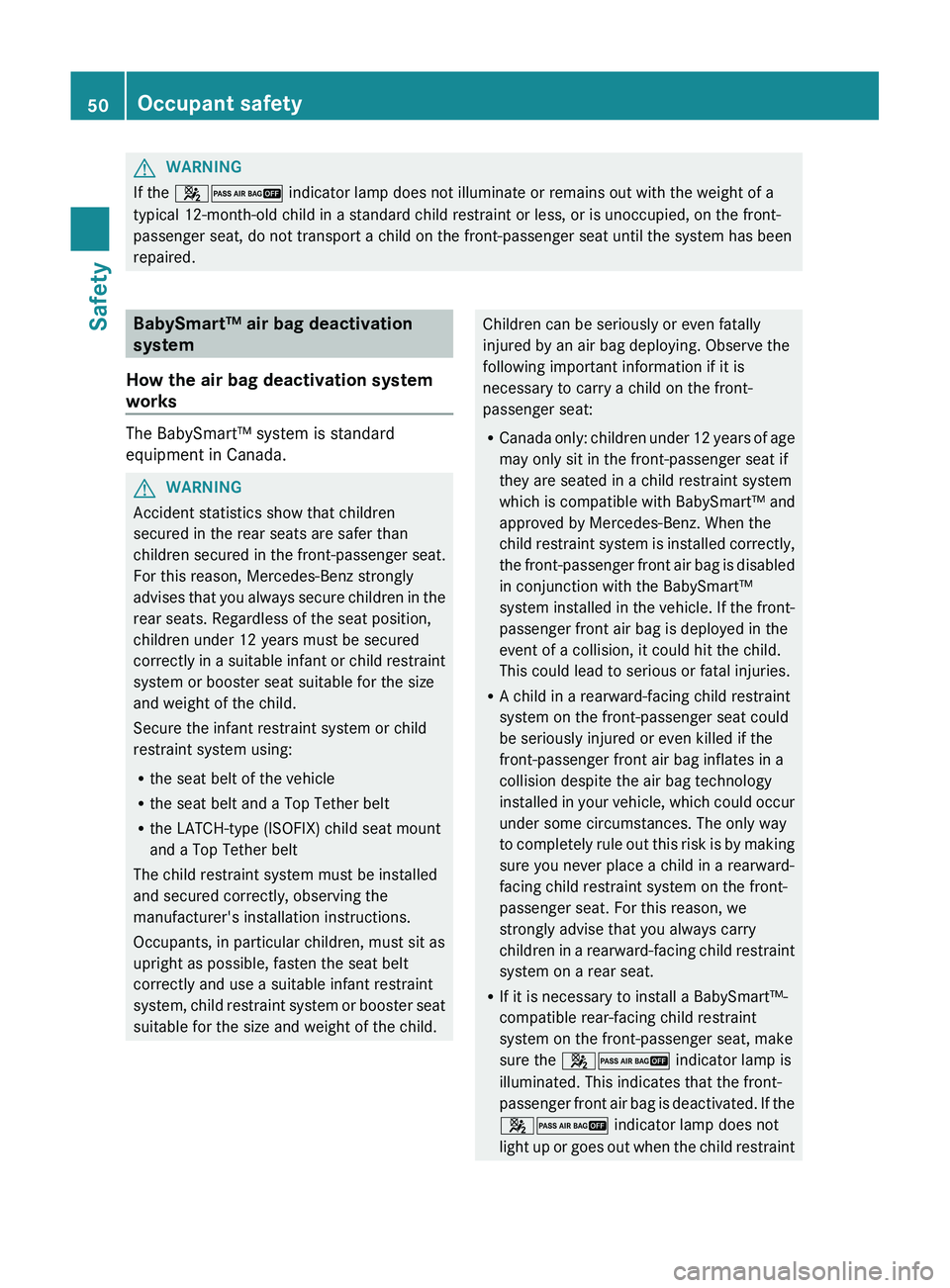
GWARNING
If the 42 indicator lamp does not illuminate or remains out with the weight of a
typical 12-month-old child in a standard child restraint or less, or is unoccupied, on the front-
passenger seat, do not transport a child on the front-passenger seat until the system has been
repaired.
BabySmart™ air bag deactivation
system
How the air bag deactivation system
works
The BabySmart™ system is standard
equipment in Canada.
GWARNING
Accident statistics show that children
secured in the rear seats are safer than
children secured in the front-passenger seat.
For this reason, Mercedes-Benz strongly
advises that you always secure children in the
rear seats. Regardless of the seat position,
children under 12 years must be secured
correctly in a suitable infant or child restraint
system or booster seat suitable for the size
and weight of the child.
Secure the infant restraint system or child
restraint system using:
R the seat belt of the vehicle
R the seat belt and a Top Tether belt
R the LATCH-type (ISOFIX) child seat mount
and a Top Tether belt
The child restraint system must be installed
and secured correctly, observing the
manufacturer's installation instructions.
Occupants, in particular children, must sit as
upright as possible, fasten the seat belt
correctly and use a suitable infant restraint
system, child restraint system or booster seat
suitable for the size and weight of the child.
Children can be seriously or even fatally
injured by an air bag deploying. Observe the
following important information if it is
necessary to carry a child on the front-
passenger seat:
R Canada only: children under 12 years of age
may only sit in the front-passenger seat if
they are seated in a child restraint system
which is compatible with BabySmart™ and
approved by Mercedes-Benz. When the
child restraint system is installed correctly,
the front-passenger front air bag is disabled
in conjunction with the BabySmart™
system installed in the vehicle. If the front-
passenger front air bag is deployed in the
event of a collision, it could hit the child.
This could lead to serious or fatal injuries.
R A child in a rearward-facing child restraint
system on the front-passenger seat could
be seriously injured or even killed if the
front-passenger front air bag inflates in a
collision despite the air bag technology
installed in your vehicle, which could occur
under some circumstances. The only way
to completely rule out this risk is by making
sure you never place a child in a rearward-
facing child restraint system on the front-
passenger seat. For this reason, we
strongly advise that you always carry
children in a rearward-facing child restraint
system on a rear seat.
R If it is necessary to install a BabySmart™-
compatible rear-facing child restraint
system on the front-passenger seat, make
sure the 42 indicator lamp is
illuminated. This indicates that the front-
passenger front air bag is deactivated. If the
42 indicator lamp does not
light up or goes out when the child restraint50Occupant safetySafety
Page 53 of 384
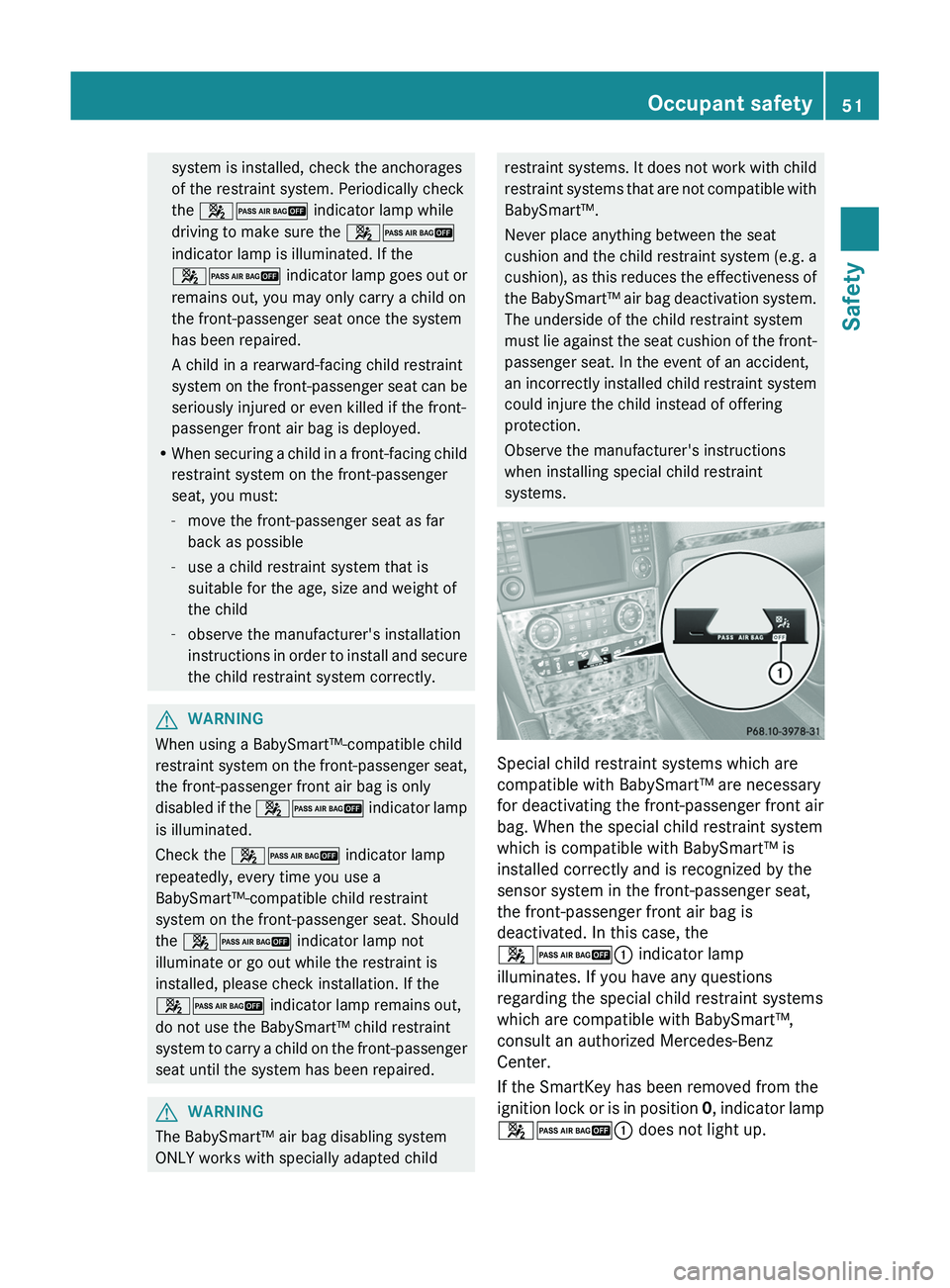
system is installed, check the anchorages
of the restraint system. Periodically check
the 42 indicator lamp while
driving to make sure the 42
indicator lamp is illuminated. If the
42 indicator lamp goes out or
remains out, you may only carry a child on
the front-passenger seat once the system
has been repaired.
A child in a rearward-facing child restraint
system on the front-passenger seat can be
seriously injured or even killed if the front-
passenger front air bag is deployed.
R When securing a child in a front-facing child
restraint system on the front-passenger
seat, you must:
- move the front-passenger seat as far
back as possible
- use a child restraint system that is
suitable for the age, size and weight of
the child
- observe the manufacturer's installation
instructions in order to install and secure
the child restraint system correctly.GWARNING
When using a BabySmart™-compatible child
restraint system on the front-passenger seat,
the front-passenger front air bag is only
disabled if the 42 indicator lamp
is illuminated.
Check the 42 indicator lamp
repeatedly, every time you use a
BabySmart™-compatible child restraint
system on the front-passenger seat. Should
the 42 indicator lamp not
illuminate or go out while the restraint is
installed, please check installation. If the
42 indicator lamp remains out,
do not use the BabySmart™ child restraint
system to carry a child on the front-passenger
seat until the system has been repaired.
GWARNING
The BabySmart™ air bag disabling system
ONLY works with specially adapted child
restraint systems. It does not work with child
restraint systems that are not compatible with
BabySmart™.
Never place anything between the seat
cushion and the child restraint system (e.g. a
cushion), as this reduces the effectiveness of
the BabySmart™ air bag deactivation system.
The underside of the child restraint system
must lie against the seat cushion of the front-
passenger seat. In the event of an accident,
an incorrectly installed child restraint system
could injure the child instead of offering
protection.
Observe the manufacturer's instructions
when installing special child restraint
systems.
Special child restraint systems which are
compatible with BabySmart™ are necessary
for deactivating the front-passenger front air
bag. When the special child restraint system
which is compatible with BabySmart™ is
installed correctly and is recognized by the
sensor system in the front-passenger seat,
the front-passenger front air bag is
deactivated. In this case, the
42 : indicator lamp
illuminates. If you have any questions
regarding the special child restraint systems
which are compatible with BabySmart™,
consult an authorized Mercedes-Benz
Center.
If the SmartKey has been removed from the
ignition lock or is in position 0, indicator lamp
42 : does not light up.
Occupant safety51SafetyZ
Page 55 of 384
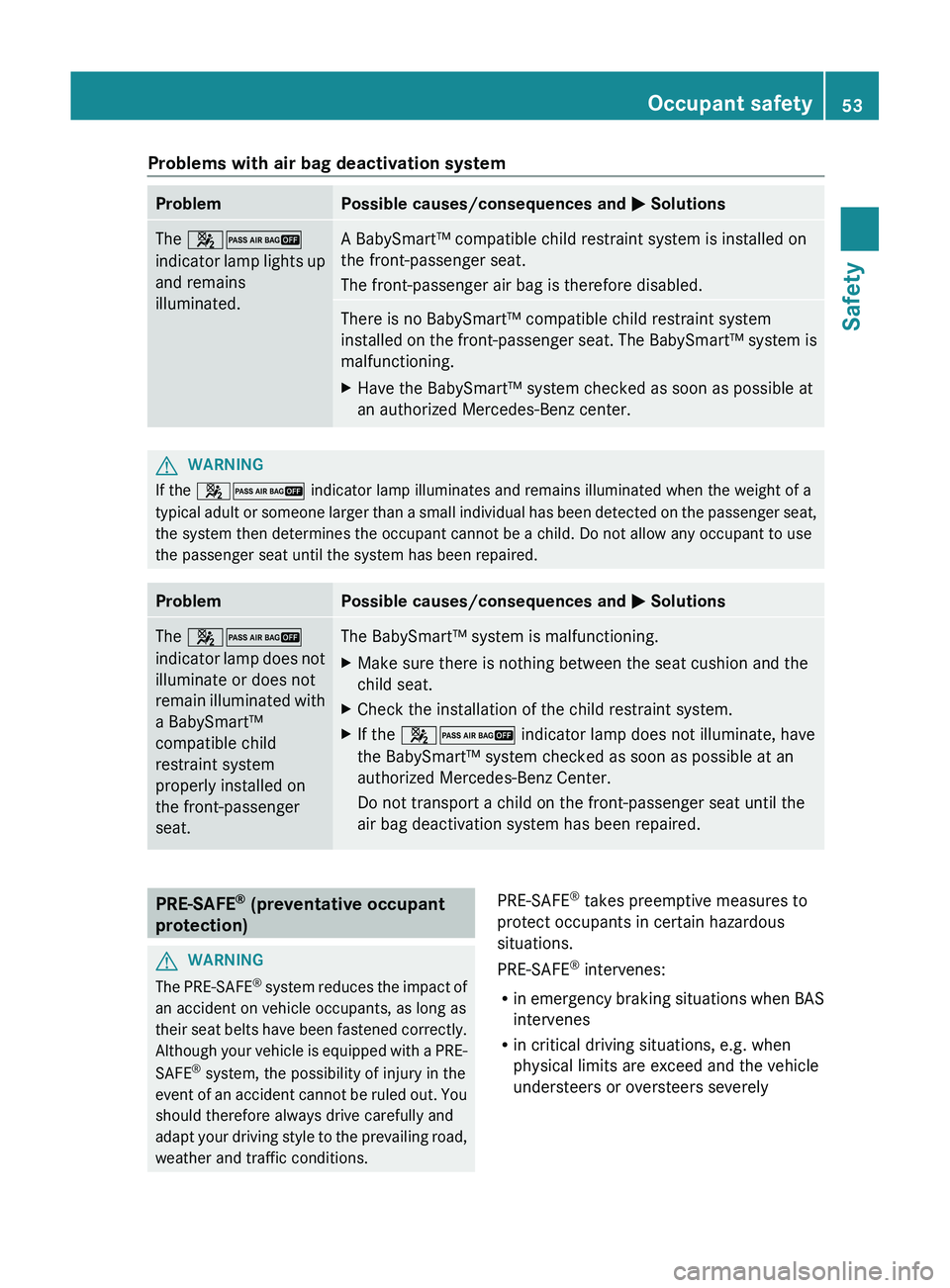
Problems with air bag deactivation systemProblemPossible causes/consequences and M SolutionsThe 42
indicator lamp lights up
and remains
illuminated.A BabySmart™ compatible child restraint system is installed on
the front-passenger seat.
The front-passenger air bag is therefore disabled.There is no BabySmart™ compatible child restraint system
installed on the front-passenger seat. The BabySmart™ system is
malfunctioning.XHave the BabySmart™ system checked as soon as possible at
an authorized Mercedes-Benz center.GWARNING
If the 42 indicator lamp illuminates and remains illuminated when the weight of a
typical adult or someone larger than a small individual has been detected on the passenger seat,
the system then determines the occupant cannot be a child. Do not allow any occupant to use
the passenger seat until the system has been repaired.
ProblemPossible causes/consequences and M SolutionsThe 42
indicator lamp does not
illuminate or does not
remain illuminated with
a BabySmart™
compatible child
restraint system
properly installed on
the front-passenger
seat.The BabySmart™ system is malfunctioning.XMake sure there is nothing between the seat cushion and the
child seat.XCheck the installation of the child restraint system.XIf the 42 indicator lamp does not illuminate, have
the BabySmart™ system checked as soon as possible at an
authorized Mercedes-Benz Center.
Do not transport a child on the front-passenger seat until the
air bag deactivation system has been repaired.PRE-SAFE ®
(preventative occupant
protection)GWARNING
The PRE-SAFE ®
system reduces the impact of
an accident on vehicle occupants, as long as
their seat belts have been fastened correctly.
Although your vehicle is equipped with a PRE-
SAFE ®
system, the possibility of injury in the
event of an accident cannot be ruled out. You
should therefore always drive carefully and
adapt your driving style to the prevailing road,
weather and traffic conditions.
PRE-SAFE ®
takes preemptive measures to
protect occupants in certain hazardous
situations.
PRE-SAFE ®
intervenes:
R in emergency braking situations when BAS
intervenes
R in critical driving situations, e.g. when
physical limits are exceed and the vehicle
understeers or oversteers severelyOccupant safety53SafetyZ